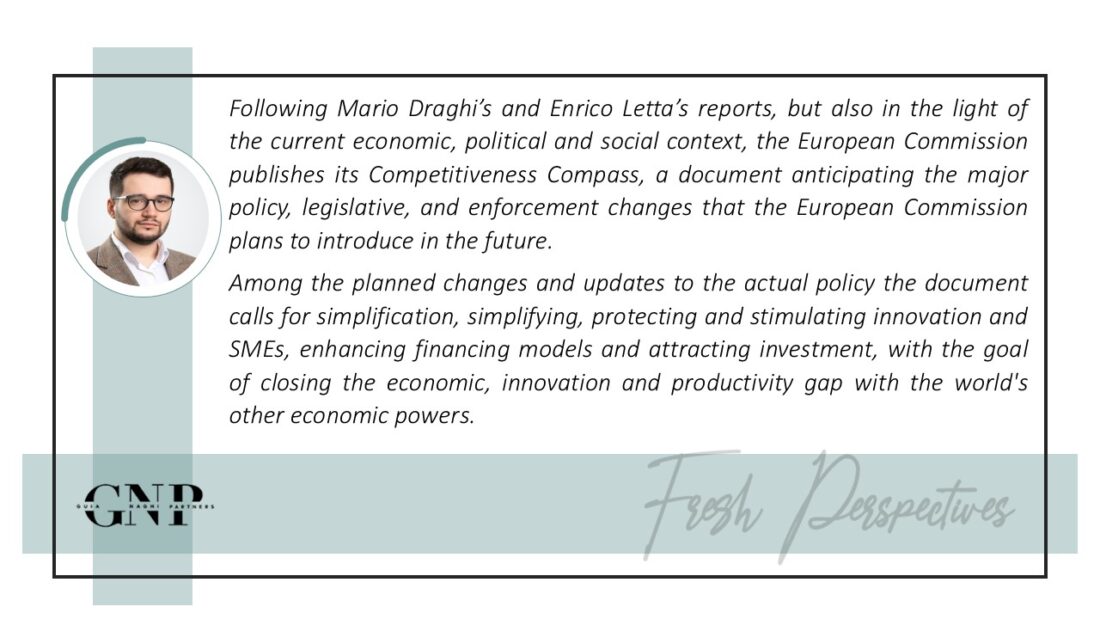Tudor Pasat – Much has been said. More is to be done. The European Commission’s Competitive Compass is bringing a lot to the table
On 29th of January, The European Commission (the “EC”) adopted and published its Competitiveness Compass for the EU, a comprehensive policy communication outlining the major endeavours the European Union („EU”) must undertake to boost the Single Market and its productivity, feasibility and attractiveness (in one word, competitiveness), in order to close the gap between the EU and the other major world economic powers.
Among various calls for policy enhancement and simplification, two major attempts have been proposed in reference to competition enforcement. The first refers to the State Aid regulatory framework, while the second concerns the revision and enforcement of several legislative frameworks, namely EU Merger Control rules, the Technology Transfer Framework and the Digital Markets Act. Notably, these policies mainly fall within the EC’s direct and undisputed authority.
I. Revising the State Aid framework a gateway through which other measures can enter
Throughout the paper, the EC underlines the need to revitalize business and industry in general, as well as targeting certain key sectors – such as energy, biotechnology, and workforce. Clearly, the revitalization of the industry, whether across the board or targeting specific sectors, will come at a cost. In this regard, the State aid regulatory framework, which is most directly within the EC’s reach, is promised to undergo reform.
It is, in fact, the European Commission that appears to finally acknowledge that the regulatory burden has become a hindrance to Europe’s competitiveness, a challenge that is clear in the state aid mechanism as well.
Although the paper consistently emphasizes the broader need to simplify and reduce bureaucracy in the administrative processes of screening and/or authorization, pragmatically, the European Commission suggests two initial measures in state – aid matters.
- Streamlining Important Projects of Common European Interest (IPCEIs),
One crucial step towards revitalizing industry and the economy, in EC’s view, is to streamline the approval procedures of IPCEIs, as well as broadening their applicability. With the use of a new, TBD (To – be – developed) Competitiveness Coordination Tool, the EC aims to align a set of priorities in the relevant key areas to foster innovation and both public and private investments. Furthermore, should the Competitiveness Coordination Tool mature, the tool shall be used to identify new, strategic and relevant sectors in which investments will be prioritized.
- Clean energy – as the second important point in incentivising investments through state aid reform
The Compass also suggests thatencouraging the production of low-carbon technologies and circular economy practices through financial incentives and state aid reform could also serve for the better.
II. The EU merger control rules, TTBER and the Digital Markets Act as enforcement pillars in safeguarding competition within the Single Market
Merger Control Rules to be revised
The European Commission is pursuing changes to the merger review and notification rules, promising predictability and fairness in the application of the law. Given the knock-on effects of the Illumina-Grail case at the national member state level, it was almost expected for the European Commission to introduce such a message and initiative. However, it is unclear how below – threshold mergers will be addressed in the future, and this matter must also be tackled by the EC, as national competition authorities already started to take positions, generally in favour of having competence over these transactions.
Technology Transfer Framework
Another approach undertaken by the EC is to update the Technology Transfer Block Exemption Regulation and the Technology Transfer Guidelines, regulations used to assess technology licensing agreements, with the aim of promoting technology dissemination, supporting early-stage research and development, and encouraging innovation.
Enforcement of the Digital Markets Act („DMA”)
The EC re-emphasizes that the Digital Markets Act could help break open closed ecosystems, allowing innovative businesses to offer new digital services to customers. As a result, there will likely be an ongoing focus on closed ecosystems under the DMA. The EC also aims to introduce a Digital Networks Act, its purpose being to boost incentives for building future digital networks, cut compliance costs and administrative burdens, and enhance digital connectivity for end-users.
Conclusion
As anticipated within the title, much has been said within the EC’s Competitive Compass, not only to the topics addressed. The targets and measures that the EC is proposing are diverse, interconnected and highly complex and at times seem to be contradictory (the EC vouches for simplicity and predictability for the private sector, yet suggests many reforms and new legislative frameworks and implementing tools). From a competition law perspective, the plan is notably ambitious, with the proposed measures predominantly regulatory in nature, as the document contains only limited references to a potential antitrust policy.





No Comments